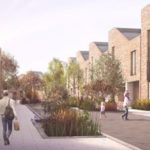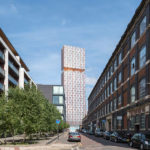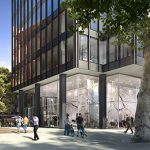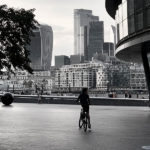One of the phrases we often use in the context of the climate crisis and transport is ‘turning the dial down’. However much it might technically be possible to ‘go car free’, we always have to balance the need for accessibility, the transport reality experienced by different communities in different places, and our engrained habits and behaviours. But we also need to consider how we can appropriately push boundaries to make changes which reduce emissions from transport and move us towards environmental targets, such as net zero.
In that respect, residential development might be considered a particularly hard nut to crack. Take a look at most out-of-town housing developments (and some urban developments too) and you’ll find there is either a requirement, or an expectation, to provide (often multiple) car parking spaces for each dwelling.
Inner-city ‘residential park and ride’
We recently worked on a high-level feasibility study for a large residential masterplan. With residential units in the centre of a city well-known for having peripheral park and ride sites, and the developer looking to avoid having car parking in the development, we struck on the idea of ‘reverse park and ride’. Using this approach residents would park their car at a ‘park and ride’ site on the edge of the city and travel by bus to reach their home. Possibly even more appealing in our current economic climate, would be to give residents the option to not own a car at all, but instead to have access to cars via car clubs at the park and ride site. And taking the idea one step further, how many bus journeys could be replaced altogether if we substituted buses with cycle paths and secure cycle parking at the park and ride site?
It’s a different solution which could combine health, climate and economic benefits. For developers this type of thinking could represent a real opportunity to maximise value for money from a development – increasing residential density without having to lose space for car parking. By taking away car parking, which would traditionally be provided within a basement in the city centre, the need to excavate basements could also be removed. Similarly, removing parking spaces at ground level frees up space for public realm or further residential development. Reduced car parking means lower demand which leads to less space being used for roads.
Town to country
Stepping outside of the city centre context, we know that there are challenges. But there are still opportunities for strategic transport thinking.
We’re currently considering strategic residential development, and how we could apply a ‘Center Parcs-style’ approach. Visitors to Center Parcs have very limited access to take a car to their lodge. Once luggage has been dropped, the car is parked in a large, remote (and inconveniently located) car park. As a result the car is used less than usual – it likely sits in the car park for the duration of the stay; it’s sometimes the first time guests at Center Parcs realise how little they miss their car when key amenities are conveniently located. The convenience factor of a car being parked outside on the drive is taken away – in that situation, do we walk or cycle instead if we’re nipping to the shops for a loaf of bread?
So, how might we apply that approach to new residential development?
Continuing the Center Parcs analogy, how could things be different if instead of a leisure complex, a public transport interchange such as a rail station was located at the centre of a masterplan? When we start to think about these kinds of changes, we’re addressing how we might start to take down barriers to our habitual behaviours; when we’re making decisions about how to travel on a longer journey, do we travel five to 10 minutes to get access to our cars – or might we prefer to walk for five minutes to get to a rail station and travel by public transport?
Strategic thinking for strategic sites
Of course, transport planning isn’t quite so simplistic. We’re not only experiencing a ‘climate crisis’ at the moment – we’re also (in the UK) in the midst of a severe housing shortage and a cost-of-living crisis. The overriding need – certainly in southeast England – is to provide more housing, and this unfortunately means it’s easy to continue providing very car-dependent communities. No-one would dispute the need for housing, but we think it’s time to move away from ‘housing at all costs’ towards a balance of taking new ideas and working harder to try and provide developments with less dependency on the car.
At a high level, for strategic sites this requires political will and strategic thinking. It means thinking through the location of a strategic residential development site and placing it close to a rail line, where there might be the potential for a new station and the opportunity to link into public transport networks. It means ensuring that significant infrastructure investment is realised and in place in time for first occupation so that travel habits based around the car do not become established. And, it means coupling with a low-car strategy; putting additional measures in place that make using the car less attractive in combination with offering a great alternative, like a new station and ‘reasonably-priced’ public transport.
It could mean incentivising ultra-sustainable access developments. For example, might the merit of a site located very close to an existing railway station be reflected through the planning process to acknowledge and promote the potential for measures that reduce private car demand?
On a human scale it means thinking about what people really want. We believe that more and more people are looking for the flexibility to be less reliant on their car. We know that there are practical issues to consider in day-to-day life. It’s a big ask for a family with young children, and a carload of pushchairs and shopping, to park a 10-minute walk away from home. But that’s where the detail comes in and we start to consider bespoke strategies, such as occasional access to the front door for say two or three nights per week, or maybe even per month.
It’s all about starting the journey, step by step – looking to try and be more sustainable, to try and improve the quality of lived experience that people have and give people other options that are not reliant upon using private cars, but still give access to the car when needed. And that’s what we mean by ‘turning the dial down’.




